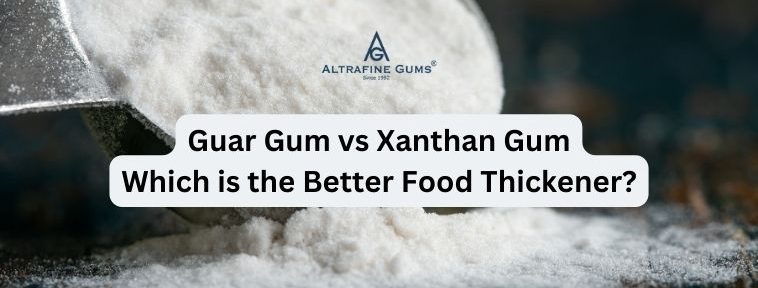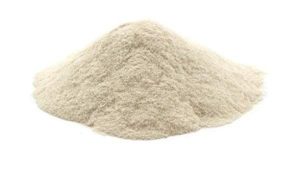- Home
- Guar Gum Powder
- Guar Gum vs Xanthan Gum: Which is the Better Food Thickener?

Guar Gum vs Xanthan Gum: Which is the Better Food Thickener?
When it comes to food production, achieving the perfect consistency and texture can make or break a product. Among the most popular natural thickening agents are Guar Gum and Xanthan Gum. Both have unique properties, and their use varies widely across food industries. But which one is better for your recipe or product? In this article, we will explore the differences between these two thickeners, focusing on texture, solubility, stability, and dietary considerations to help you make an informed decision.
Overview of Guar Gum and Xanthan Gum
Guar Gum is a natural thickening agent derived from the seeds of the guar plant (Cyamopsis tetragonoloba). It has been used for centuries in food and other industries due to its ability to absorb water and create a gel-like consistency. Guar gum is highly effective in very small quantities, making it a cost-effective thickener for many types of food products, from sauces and soups to ice cream and baked goods.
On the other hand, Xanthan Gum is produced through the fermentation of sugar by the bacterium Xanthomonas campestris. It was discovered in the 1960s and quickly became a favorite in the food industry due to its remarkable thickening and stabilizing properties. Xanthan gum has the ability to thicken liquids even in very low concentrations and is widely used in gluten-free baking and as a stabilizer in salad dressings and sauces.

Texture and Thickness in Food Applications
When comparing guar gum and xanthan gum, one of the key differences is the type of texture each provides. Guar gum creates a softer, more elastic texture in foods, which is ideal for dairy products, frozen desserts, and baked goods. Its high water-absorbing properties help retain moisture, which can be particularly useful in products like gluten-free bread, where maintaining softness is challenging.
In contrast, xanthan gum provides a thicker, more viscous texture and can create a slimy or sticky feel in some applications. It is particularly useful in thickening low-fat or low-oil dressings, as it can give the appearance of creaminess without adding fat. Xanthan gum is also known for its ability to create stable emulsions, which makes it ideal for sauces, gravies, and beverages. However, its texture may not be suitable for all applications, especially where a softer or fluffier texture is desired.
The choice between these two thickeners often comes down to the desired texture of the final product. If you need a smooth, creamy consistency, xanthan gum may be the better choice. However, for lighter, more elastic textures, guar gum might offer superior results.
Solubility and Stability in Recipes
Another important factor when choosing between guar gum and xanthan gum is their solubility and stability in various recipes. Both are highly soluble in water, but xanthan gum dissolves more easily in cold water compared to guar gum, which may require slightly warmer temperatures or more mixing to dissolve completely.
When it comes to stability, xanthan gum is generally more heat-stable and pH-stable than guar gum. This makes it the preferred choice for products that are exposed to extreme temperatures or acidity, such as salad dressings with vinegar or cooked sauces. It also performs well in frozen and reheated foods, where guar gum may lose some of its thickening power.
However, guar gum has a stronger thickening ability in cold applications, making it an excellent choice for ice creams, cold sauces, and frozen desserts. It also works well in batters and doughs that do not require heating during preparation.
Dietary Considerations and Allergies
Dietary preferences and potential allergies are critical factors to consider when choosing between guar gum and xanthan gum. Both gums are gluten-free and are commonly used in gluten-free recipes, particularly in baked goods. They can help mimic the elasticity and structure that gluten provides in traditional baking.
Guar gum is plant-based, making it suitable for vegans and those following a plant-based diet. It is also rich in soluble fiber, which can offer digestive benefits, although it may cause bloating or gas in some individuals when consumed in large amounts. Since guar gum is derived from legumes, individuals with a legume allergy may want to avoid it.
Xanthan gum, on the other hand, is produced by bacterial fermentation, typically from a sugar source such as corn, soy, or wheat. While it is generally safe for consumption, individuals with severe allergies to corn or soy may want to be cautious, as trace amounts could be present. Additionally, xanthan gum is considered to be low in calories, and some people find it easier to digest than guar gum.
For those with specific dietary requirements or allergies, both guar gum and xanthan gum have their pros and cons. If a plant-based, high-fiber option is needed, guar gum is the better choice. If heat stability and ease of digestion are top priorities, xanthan gum might be the better option.
Conclusion: Which Thickener is Best?
When deciding between guar gum and xanthan gum, there is no definitive answer to which one is better. The choice depends largely on the specific food application and the desired texture, stability, and dietary considerations.
- Guar Gum is highly effective in cold applications, provides a soft and elastic texture, and is rich in fiber. It is ideal for ice creams, dairy products, and gluten-free baking where moisture retention is important.
- Xanthan Gum offers superior heat stability, forms stronger emulsions, and dissolves easily in cold water. It excels in sauces, dressings, and products that need to withstand cooking or acidic environments.
Ultimately, the best food thickener depends on your needs. For light and fluffy textures, guar gum is your go-to. For stable, thick emulsions in acidic or heated products, xanthan gum is unbeatable. Both are powerful, versatile thickeners that can enhance the texture and consistency of a wide range of food products.
FAQs About Guar Gum vs Xanthan Gum
1. Can I substitute guar gum for xanthan gum in recipes?
Yes, you can often substitute guar gum for xanthan gum in recipes, but the results may vary. Xanthan gum tends to produce a more stable and thicker consistency, so you may need to adjust the quantities accordingly.
2. Which thickener is better for gluten-free baking?
Both guar gum and xanthan gum are commonly used in gluten-free baking. However, guar gum is better for achieving a softer, more elastic texture, while xanthan gum provides more structure and stability.
3. Are guar gum and xanthan gum vegan-friendly?
Yes, both guar gum and xanthan gum are suitable for vegans. Guar gum is derived from a plant, while xanthan gum is produced through bacterial fermentation, typically from plant-based sugars.
4. Are there any side effects of consuming guar gum or xanthan gum?
In small amounts, both are safe to consume. However, guar gum can cause digestive discomfort, such as bloating or gas, when consumed in large quantities. Xanthan gum is generally easier to digest but may cause issues for individuals with corn or soy allergies.
5. Which gum is more cost-effective?
Guar gum is typically more cost-effective than xanthan gum. It requires smaller amounts to achieve the desired thickness, making it a more economical choice for large-scale food production.
6. Can xanthan gum be used in cold applications like ice cream?
Yes, xanthan gum works well in cold applications, but guar gum is often preferred for ice creams and frozen desserts due to its superior moisture-retaining properties.
